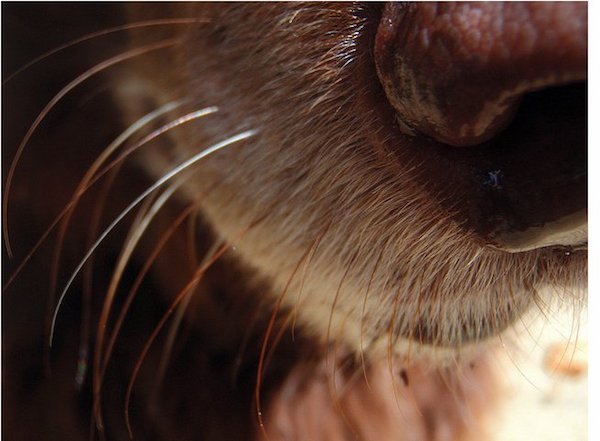
For a lively debate among dog people in the fancy, start a discussion about: 1) Dog Food; 2) Collars vs harnesses; 3) Vaccinations; 4) Training methods/tools; 5) Style vs type; 4) Judges who exhibit their own dogs; 5) Advertising wins; 6) Show dogs vs performance dog type, and – let’s face it – probably thirty other topics we’ve missed.
Looked as a unique species, dog people are enthralling. We are generally down-to-earth, frequently well informed, always colorful, often earthy, and certainly opinionated! Human nature, we suppose, suggests that we seek validation for our own choices by finding others who agree with us, and when we encounter those whose opinions are at odds with our own, well, it’s off to the races. We seem to get especially “exercised” when any of the aforementioned topics are being discussed. There’s one other subject that can create a rift among people who otherwise have a breed in common. Are you ready for it?
Whiskers.
Take this next part to heart. We have no “dog in this fight,” as they say. Our own breed is so hairy that a Puli would have to have whiskers growing on their teeth for us to notice. There are, however, immutable facts about whiskers, and they are this:
1) Some breed standards mention whiskers and how to handle them, and some don’t;
2) Whiskers have a purpose.
With this post, we simply report what is written, and we blame our friend, “Sarah,” for bringing to our attention how very interesting whiskers are. We like Sarah because she’s as nerdy as we are about this stuff. How nerdy? She put together a spreadsheet on whiskers just out of curiosity.
We know, right?
To be honest, we hesitated writing this post. Talking about whiskers, what they do, and their purpose, and then mentioning that some breed standards make trimming optional seems to invite criticism. Please don’t be that person. We didn’t write the standards, nor did we invent the science. We are this guy:
The majority of breed standards either don’t mention whiskers, or write that they must be left alone: To wit: “Not to be removed, “not to be trimmed,” “remain intact,” “untrimmed preferred,” “left natural,” or a “preference that whiskers remain intact” appears in the standards of the Tibetan Spaniel, Staffordshire Bull Terrier, Samoyed, Rat Terrier, Newfoundland, Finnish Spitz, Shiba Inu, Miniature American Shepherd, Leonberger, Irish Red and White Setter, Entlebucker Mountain Dog, Border Collie, and American Hairless Terrier.
Some breed standards are more to the point: The Lhasa Apso breeds calls for “good whiskers,” the Border Terrier writes that “a few short whiskers are natural to the breed,” and “thick whiskers…accentuate the rectangular shape of the head” in reference to the Miniature Schnauzer. Not to be forgotten: “Whiskers serve a specific function and it is preferred that they not be trimmed” in the Flat Coated Retriever standard, and for a Nova Scotia Duck Tolling Retriever,”Whiskers must be present.”
Whiskers are optional, may be trimmed or left natural, permitted but not preferred (or as we think of it, “dealer’s choice”) for Golden Retrievers, Keeshonden, Great Danes, Cardigan Welsh Corgi, Siberian Huskies, Vizslak, Schipperke, Chow Chow, and Clumber Spaniels.
Don’t even think about removing whiskers in the American Eskimo Dog: “There is to be no trimming of the whiskers or body coat and such trimming will be severely penalized.” Ditto for the Icelandic Sheepdog: “Specimens where the coat or whiskers have been altered by trimming or clipping shall be so severely faulted as to be effectively eliminated from competition.” In the Pekingese, it’s written that “whiskers add to the desired expression.”
It’s likely that we’ve missed a breed or more, and we invite you to add your breed’s stand on whiskers, but at this point, we move on to what science tells us about them.
Whiskers are among the first hairs to develop on a puppy, and will become twice as thick and coarser than regular dog hair. Their roots are set three times deeper, and they’re packed with enough nerves and blood vessels to make each individual whisker a super sensitive receptor to movement. In fact, they are sensitive to touch, and perceptive enough to sense a change in wind flow.Brushing whiskers against their natural direction, or even petting them, can actually be painful to some dogs which may be why some people chose to remove them.
Unlike the neatly arranged 12 whiskers in four rows on each side of a cat’s face, dog whiskers are more varied in their pattern depending on their breed and genetics. Certain whiskers that stick out from the sides of a dog’s muzzle aren’t technically whiskers at all, they’re vibrissae (from the Latin word “vibrio” which means to vibrate) and they’re typically found in clumps. These hairs transmit information to a dog’s brain about the dog’s balance and movement, and without them, dogs can struggle to evaluate their spatial relationship to other things.
If you think of whiskers as being as sensitive as human fingertips, you get a sense of their purpose.
Image found on Pinterest and happily credited upon receipt of information
